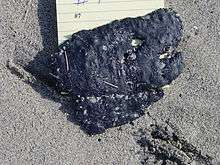Bacillus submarinus
Bacillus submarinus is a species in the genus Bacillus, meaning it is rod shaped while being capable of producing endospores.[1] B. submarinus is Gram + , where there is a thick layer of peptidoglycan in its cell wall.[2]
| Bacillus submarinus | |
|---|---|
| Scientific classification | |
| Domain: | Bacteria |
| Phylum: | Firmicutes |
| Class: | Bacilli |
| Order: | Bacillales |
| Family: | Bacillaceae |
| Genus: | Bacillus |
| Species: | B. submarinus |
| Binomial name | |
| Bacillus submarinus | |
Description
Bacillus submarinus is a gram positive, aerobic meaning that it requires oxygen for metabolism. B. submarinus is a sporulating bacteria which is when the cell puts it genetic information in a spore during a cell's dormant phase, rod-shaped, bacterium of the genus Bacillus that is commonly found in the ocean at extreme depths and pressures.[3] As with other members of the genus Bacillus, it can form an endospore a bud that contains genetic information in the chance the bacteria cell dies, later when conditions become more hospitable the bacteria returns, surviving extreme conditions.[2]
Habitat
This species is commonly found in the ocean waters, primarily in the Atlantic Ocean. Bacillus submarinus is able to live in oceans at a depth of more than 5000 m, withstanding extreme hydrostatic pressure that is above Pa or around 15954 Psi. In contrast, the human femur can only withstand a maximum of 1,700 Psi before shattering.[4]
Reproduction
Bacillus submarinus divide symmetrically to make two daughter cells, producing a single endospore that can remain viable for decades and is resistant to unfavourable environmental conditions such as ocean acidification. They do not reproduce like eurkaryotic cells by mitosis but, a process known as binary fission. In binary fission the DNA in the prokaryote is not condensed in structures similar to chromosomes, but make a copy of the DNA and the cell divides in half.
Uses

Bacillus submarinus is proven to decompose oil that is found in the ocean such as after an oil spill. As B. submarinus begins the process of decomposing oil in the ocean they form tarballs. In these tarballs the B. submarinus works with other organisms such as Chromobacterium violaceum and Candida marina to change the chemical structure of the oil by decomposing it and causing the molecules in oil to bond to other materials around organism.[5][6]
References
- http://www.stgau.ru/company/personal/user/7867/files/lib/Микробиология/Агрономия/Лекции/2.docx. Missing or empty
|title=(help) - Tortora. Microbiology an Introduction 11th edition.
- "Bacillus". Medical Microbiology. 4th edition. University of Texas Medical Branch at Galveston. 1996. ISBN 9780963117212.
- "How Much PSI Does It Take to Break Human Bone".
- "What are Tarballs?".
- "Binary Fission and other Forms of Reproduction in Bacteria".